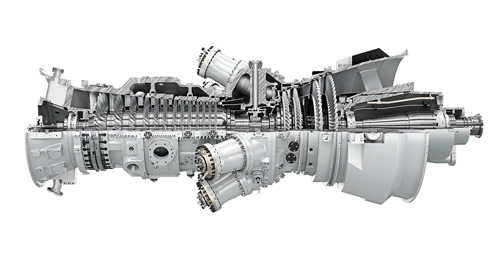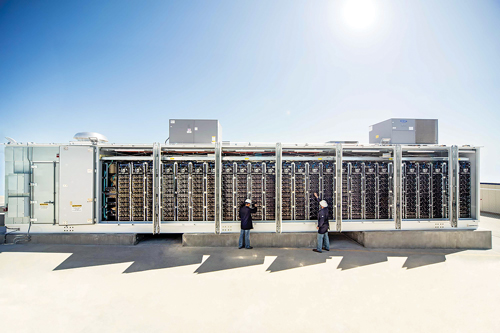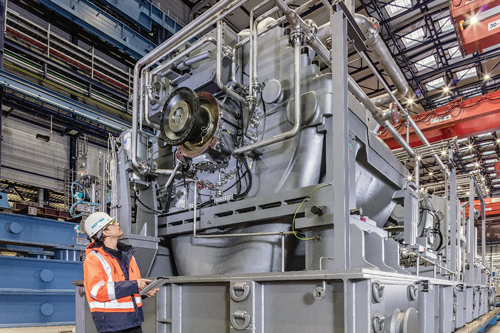Making low-emissions LNG a reality
Last year was a milestone year for LNG. In 2019, roughly 40 metric MMtpy of additional supply became available, and 71 metric MMtpy of new liquefaction capacity were announced—both record highs. Overall global demand grew by 12.5% to 359 metric MMtpy. This trend is expected to continue, with demand projected to double through 2040 as the world increasingly shifts to an energy system driven by renewable energy and lower-carbon feedstocks.1
Despite its growing role in the global energy mix, the environmental impact associated with bringing natural gas in the form of LNG to destination markets is being critically examined by activists, investors, lenders and regulatory bodies. The industry now faces the difficult task of reducing emissions and effectively decarbonizing LNG production.
One companya recently entered into a formal agreement with a global energy leaderb with the hope of achieving this goal. As part of the contract, the company is conducting studies to evaluate a variety of possible liquefaction and power plant designs that can be leveraged to develop low-emissions LNG facilities. The studies will also seek novel ways to enhance performance in other critical areas, such as reliability, maintainability and development costs.
In this article, the authors outline specific concepts and technologies used in the studies and discuss how the industry can begin taking a more holistic approach to reducing plant emissions.
Liquefaction facility design. When it comes to optimization efforts in an LNG facility, the design of the liquefaction island often garners the most attention from owners and developers, and rightfully so. The process of cooling natural gas to –162°C is extremely energy-intensive. This process, coupled with the fact that most plants are designed to produce LNG around the clock, 365 days per year, means that even a marginal efficiency increase can translate into a substantial emissions reduction.
In recent years, electric motor-driven compression trains (i.e., E-LNG) have gained traction as a means of reducing emissions. E-LNG opens new possibilities for controlling the liquefaction process. In many instances, it can also offer advantages over gas turbines operating in mechanical drive configuration with regard to maintenance and availability. The latter can have a significant impact on carbon footprint, as estimates indicate that anywhere from 5%–10% of the total emissions from an LNG plant are a result of venting/flaring that takes place during startup, shutdown and system de-inventory.
As an example, a heavy-duty gas turbine driving an 8-metric-MMtpy compression train has an availability of 95%. After 2 yr in operation, anywhere from 10 d to 3 wk are required for scheduled maintenance. Electric drives, on the other hand, can achieve > 97%–99% availability. It is not uncommon, in fact, for motors as large as 65 MW–75 MW to run for more than 5 yr without scheduled maintenance.2
Even with these advantages, the decision between gas turbine- or electric motor-driven refrigeration trains is not so simple. A multitude of technologies can reduce emissions from gas turbines. For instance, many 50-plus-MW turbine models now come standard with dry low-emission (DLE) combustion systems, which can reduce carbon monoxide (CO) and nitrous oxide (NOx) emissions to single-digit ppm levels (FIG. 1). Inlet air chilling is another potential option. With this technology, air entering the combustor is precooled to a temperature that maximizes efficiency and minimizes the specific fuel consumption of the turbine.
 |
| FIG. 1. A 41-MW, mechanical-drive gas turbine drive for LNG main refrigerant trains and power generation producing single-digit NOx emissions. |
These technologies, and others, can potentially tip the scale in favor of gas turbine-driven compression trains. Several site-specific variables need to be evaluated when determining which rotating equipment solution will deliver the lowest carbon footprint over the life of the plant.
Power generation. In the context of decarbonization, one of the most critical questions that must be answered when evaluating an E-LNG solution is where the electricity is being generated.
An ideal scenario, from an emissions perspective (and, in many cases, a CAPEX and OPEX perspective), would be for the LNG plant to utilize electricity from a low-carbon external grid (i.e., combined-cycle power plant with integration from renewable energy like hydropower, etc.). However, this is not an option for most existing and prospective LNG projects, particularly those located in remote areas.
In cases where grid connection is not feasible, a dedicated onsite power plant must be constructed. Gas turbines operating in open (i.e., simple) cycle configuration have traditionally been the design of choice for LNG plants. However, when minimizing the emissions profile of the facility is a priority, a strong case can be made for the implementation of a combined-cycle design.
A single-shaft industrial gas turbine operating in an open-cycle configuration has a thermal efficiency of around 25%–30%, with emissions up to 250 kg CO2/metric t of LNG produced. A combined-cycle plant, on the other hand, has an efficiency of anywhere from 55%–65%.
Once again, the decision between simple cycle vs. combined cycle requires the consideration of many factors—for example, if waste heat from gas turbine exhaust, which would typically go to the heat recovery steam generator (HRSG) in the combined-cycle plant, can be better utilized to serve some other process outside of the power facility.
CAPEX is another crucial decision driver. Generally speaking, the cost to build a combined-cycle facility is substantially higher than a simple-cycle plant of similar output. One potential strategy for closing this gap is the adoption of standards from the utility industry. Many LNG facility power plants in operation today are based on specifications from other oil and gas applications, which are not necessarily well aligned with LNG. Adoption of utility standards can reduce “over-specification” and potentially lower power plant CAPEX by as much as 20%.
In any scenario, the liquefaction facility should be evaluated in conjunction with the power plant. Traditionally, the parties involved with the design and engineering of these facilities have operated in silos, with different mindsets and objectives.
Close collaboration between equipment manufacturers, contractors and owners facilitates optimization of the entire plant—for example, by evaluating the availability of all required heat and power during normal, steady-state operating of the LNG facility, as well as during startup, shutdown and upset scenarios. The goal should be to develop a project-specific power solution that delivers the lowest emissions profile over the design life.
Built-in flexibility, which allows for the future incorporation of emissions-reducing technologies, such as carbon capture and sequestration (CCS) or conversion of the plant from a simple-cycle to combined-cycle configuration, are other aspects that may warrant consideration.
Renewables and energy storage. In cases where plants can tie into an external grid that has high penetration from renewables, substantial emissions reductions are possible. However, the problem of intermittency still exists. Plant operators cannot afford to have LNG production shut down or temporarily curtailed because the wind is not blowing or the sun is not shining. These renewables are available 2,500 hr/yr, representing just 30% of the 8,500 hr required for the operating profile of a power plant associated with a baseload facility like an LNG plant. This has been one of the biggest hurdles on the way to bringing clean power to continuous process facilities like liquefaction plants.
Battery storage can offer a solution to this problem by allowing plants to adopt hybrid power models and create new redundancy schemes (FIG. 2). In such cases, renewables, like solar photovoltaic or wind, are used as a substitution for gas consumption (when possible). During times of excess electricity production, power can be stored in batteries. These batteries can provide instantaneous power to the plant in the event of an external grid disruption. This minimizes the need for load shedding and reduces the likelihood of having to scale back production by bridging the gap between the time when the main power is lost and when the standby gas turbine starts up.
 |
| FIG. 2. Battery storage offers a solution to intermittency by allowing plants to adopt hybrid power models. |
Also, batteries potentially can be used for backup supply in the event of an outage of one or more gas or steam turbines in the onsite power plant. This provides more flexibility with regard to redundancy philosophies and opens the door to potentially employing an n+1 scheme instead of an n+2 scheme. In some cases, it may be possible to eliminate the need for spare gas turbines.
All scenarios require comprehensive energy balance analyses and feasibility studies to ensure reliable electricity supply. Additional studies can ensure that power solutions align with the operator’s objectives concerning cost and plant maintainability.
However, purely from a decarbonization standpoint, the combination of conventional power facilities with renewable energy sources, coupled with the instantaneous response of a battery energy storage system, represents a highly sustainable solution, with an emissions profile as low as 6 kg CO2/t of LNG–190 kg CO2/t of LNG.
Digitalization plays a key role. While the design of the LNG plant plays an integral role in achieving the lowest possible emissions profile, so too does optimizing the performance of the facility once it is in operation. Digitalization has emerged as one of the most effective means of achieving this goal and is increasingly being applied by operators across the industry to improve efficiency and reduce fuel consumption incrementally (FIG. 3).
 |
| FIG. 3. Digital solutions help LNG plant operators unlock hidden value in data to generate efficiency gains, emissions reductions and operational cost savings. |
As previously mentioned, a large portion of emissions from an LNG plant occurs during startup, shutdown and de-inventory. The use of digital technologies for monitoring and analysis can contribute to a reduction in these activities by enhancing overall equipment availability and optimizing maintenance cycles.
Today, a host of technologies exist in the available toolbox of an LNG plant—from advanced data analytics based on artificial intelligence (AI), to remote diagnostic services (RDS) for gas turbines, to full-scale digital twins of compressor trains (FIG. 4). When it comes to reducing emissions, the goal for operators should be to apply these solutions in ways that allow for harmonization of the entire LNG production process.
 |
| FIG. 4. LNG compressors are available for the following services: Main refrigeration, boiloff gas, end-flash gas, natural gas booster and recycle compressors. |
In E-LNG plants, this means allowing electrical infrastructure to “talk” to and exchange data with mechanical assets and associated automation systems. Traditionally, these two have been treated as separate entities and have required the application of standalone point solutions.
The Hammerfest LNG plant in Norway is a salient example of the benefits that can be achieved by bringing these areas together and employing an integrated digital approach to the entire compression train. Hammerfest was the first LNG plant in the world to feature all-electric liquefaction trains and holds the record for consecutive days in operation for an all-electric LNG facility at 218 d.
For any LNG plant, realizing the full potential of digital transformation requires extensive upfront planning. Implementing a “digital roadmap” of sorts can help identify long-term opportunities and ensure cost-effective deployment of digital solutions in the early stages of project development. Early engagement also makes it easier to implement an effective cyber defense strategy, which is vital as both the frequency and sophistication of cyberattacks continue to increase.
Driving toward a cleaner future. The global transition toward a lower-carbon energy system is accelerating. LNG will play a key role in driving toward a more sustainable future; however, the industry must begin to look introspectively at how it can decarbonize the natural gas value chain.
Owners and developers can no longer treat emissions reductions as a periphery objective. This is particularly the case for the new wave of projects set to reach final investment decision (FID) through 2025. Many of these facilities have expectations of being in operation through 2050, and the extent to which they can minimize their carbon footprint will be a competitive advantage. Stakeholders must also consider the strong likelihood of carbon taxation and how that will impact overall project economics.
As this article outlined, the quest to develop a low-emissions LNG plant is no longer a “pipe dream.” A host of proven technologies now exists, along with concepts that can be leveraged to enhance sustainability without trading off performance in availability, cost or safety. Since no two projects are the same, the key is determining which combination of technologies can be applied to deliver maximum value over the life of a plant. GP
NOTES
a Siemens Gas and Power
b Total
LITERATURE CITED
- Royal Dutch Shell, “Shell LNG outlook 2020,” February 20, 2020.
- Siemens, “Natural gas and LNG E-drive technology,” June 2018, online: https://www.cleanenergybc.org/wp-content/uploads/2015/09/LNG_E-Drive_Technology_June2018.pdf
- Bailie, B. and M. T. Russell, “How APM in LNG operations can lower TCO and boost ROI,” Hydrocarbon Processing, July 2018.
 |
GUISEPPE SACHERO is Vice President of Business Development and Sales for Siemens Energy LNG Industrial Applications Products and is responsible for positioning the company’s overall portfolio for LNG projects globally. He has 20 yr of experience in oil and gas and has held various management positions within Siemens for European contractors and strategic accounts. Mr. Sachero earned his BS degree in electrical engineering from Pavia University and an MBA degree in 2003 from the University of Bocconi.
 |
JOEL SCHUBERT is the Director of Business Development LNG, Americas, for Siemens Energy Industrial Applications business. He holds a BS degree in mechanical engineering from Rutgers University, and has more than 35 yr of experience in the oil and gas industry, including LNG. Mr. Schubert has extensive expertise in centrifugal compressors, gas turbines, steam turbines and centrifugal pumps, and more than 25 yr of experience in various leadership roles. He is a member of the Pipeliners Association of Houston Organization.




Comments